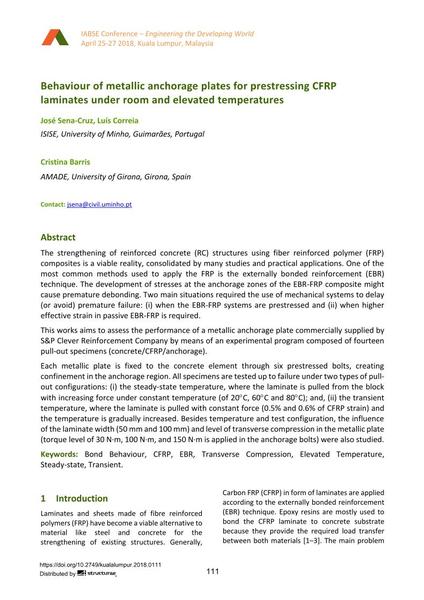Behaviour of metallic anchorage plates for prestressing CFRP laminates under room and elevated temperatures

|
|
|||||||||||
Détails bibliographiques
| Auteur(s): |
José Sena-Cruz
(ISISE, University of Minho, Guimarães, Portugal)
Luís Correia (ISISE, University of Minho, Guimarães, Portugal) Cristina Barris (AMADE, University of Girona, Girona, Spain) |
||||
|---|---|---|---|---|---|
| Médium: | papier de conférence | ||||
| Langue(s): | anglais | ||||
| Conférence: | IABSE Conference: Engineering the Developing World, Kuala Lumpur, Malaysia, 25-27 April 2018 | ||||
| Publié dans: | IABSE Conference Kuala Lumpur 2018 | ||||
|
|||||
| Page(s): | 111-118 | ||||
| Nombre total de pages (du PDF): | 8 | ||||
| DOI: | 10.2749/kualalumpur.2018.0111 | ||||
| Abstrait: |
The strengthening of reinforced concrete (RC) structures using fiber reinforced polymer (FRP) composites is a viable reality, consolidated by many studies and practical applications. One of the most common methods used to apply the FRP is the externally bonded reinforcement (EBR) technique. The development of stresses at the anchorage zones of the EBR-FRP composite might cause premature debonding. Two main situations required the use of mechanical systems to delay (or avoid) premature failure: (i) when the EBR-FRP systems are prestressed and (ii) when higher effective strain in passive EBR-FRP is required. This works aims to assess the performance of a metallic anchorage plate commercially supplied by S&P Clever Reinforcement Company by means of an experimental program composed of fourteen pull-out specimens (concrete/CFRP/anchorage). Each metallic plate is fixed to the concrete element through six prestressed bolts, creating confinement in the anchorage region. All specimens are tested up to failure under two types of pull- out configurations: (i) the steady-state temperature, where the laminate is pulled from the block with increasing force under constant temperature (of 20C, 60C and 80C); and, (ii) the transient temperature, where the laminate is pulled with constant force (0.5% and 0.6% of CFRP strain) and the temperature is gradually increased. Besides temperature and test configuration, the influence of the laminate width (50 mm and 100 mm) and level of transverse compression in the metallic plate (torque level of 30 N∙m, 100 N∙m, and 150 N∙m is applied in the anchorage bolts) were also studied. |
||||
